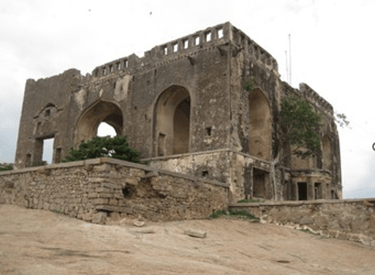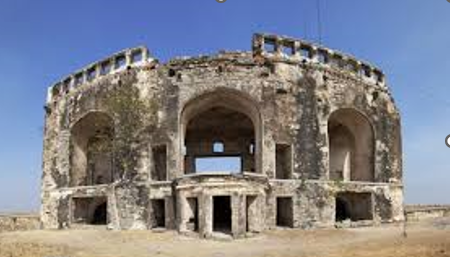Whispers of Eternity: The Timeless Majesty of Bhongir Fort
Bhongir Fort stands timeless on rugged terrain, calling those who seek the soul of history. Each ancient step tells of lost empires and enduring valour, while the summit reveals sweeping views—a landscape where legends still breathe, carved into every stone.
MINDMUSE
To reach the fort, one must pass through its two towering gates, each one flanked by massive rocks that serve as natural guardians. These entry points, once bustling with the sounds of soldiers and horses, stand as silent witnesses to centuries of history. Encircling the fort is a deep moat, a feature that ensured added protection, making the fortress even harder to breach. This combination of natural and man-made defenses rendered Bhongir Fort one of the most formidable structures in the region, a true masterpiece of medieval fortification.
As you step inside the fort, the remnants of a once-thriving citadel greet you. Granaries, where stores of grain were kept safe from siege, and military quarters, where soldiers rested between battles, stand as echoes of a bygone era. The clatter of horses' hooves would have once echoed through the fort’s courtyards, where soldiers drilled and prepared for war. In times of peace, the fort would have been a hub of activity, its inner spaces filled with the sounds of everyday life—children playing, women tending to daily chores, and traders moving through the narrow passageways.
The fort’s elevation offered a commanding view of the surrounding plains, giving its inhabitants a strategic advantage. From here, they could see approaching armies from miles away, giving them ample time to prepare their defenses. Yet, despite its military significance, Bhongir Fort was also a place of culture and civilization. The Chalukyas were patrons of the arts, and it is likely that this fortress once housed scholars, poets, and musicians who brought vibrancy to its stone halls.
Over time, the fort became a silent sentinel, its walls weathered by wind and rain but still standing tall, a testament to the brilliance of its creators. Walking through its remains today, one can almost hear the whispers of history carried on the wind, stories of battles fought, victories celebrated, and lives lived within its mighty embrace. The fort’s granaries, horseshoes, and military quarters are not just ruins; they are the remnants of a living, breathing world that once thrived here.
Bhongir Fort is more than just a historical monument. It is a living connection to the past, a place where the stones seem to remember the footsteps of those who walked before. Every boulder, every pathway, every courtyard tells a story, and for those who visit, the fort offers a chance to step back in time and feel the weight of history.
Today, Bhongir Fort stands as a reminder of the enduring legacy of the Chalukyas and their mastery of both warfare and architecture. Its imposing presence atop the hill, visible for miles around, continues to draw visitors who come to marvel at its grandeur and reflect on the stories that echo through its walls. It is a place where history and nature meet, creating a landscape of strength, resilience, and beauty.
Legends swirl around Bhongir Fort like the winds that rustle through its halls. Some say that hidden beneath the fortress are secret tunnels, leading to distant lands, once used by kings to escape or send messages across borders. Others believe that treasures still lie buried deep within, guarded by unseen spirits that roam its deserted chambers. As dusk falls, the fort transforms from a mere relic to a living legend, its walls echoing the voices of the past.
Nature has become its most loyal companion. Wild grasses sway softly in the breeze, and tiny bursts of flowers bloom defiantly among the cracks in the rocks. The air is filled with the sound of life—mongoose scurrying through the ruins, eagles soaring overhead. Even the moat, now cradling seasonal rains, forms a tranquil oasis, where plants and animals thrive in its sheltered embrace. The natural beauty that surrounds Bhongir only adds to its charm, weaving life into the very stone that has seen centuries pass.
The fort itself is a masterpiece of ancient architecture, a feat of both strength and artistry. The gates, protected by massive rocks, stand as sentinels to the fort's heart, adorned with intricate carvings that speak of a time when art and warfare were in perfect balance. And yet, beyond the fort’s military prowess, it holds a deeper resonance—a spiritual one. Even today, the remnants of temples within its walls draw pilgrims, who believe that gods once walked here, blessing the grounds with their presence.
To walk through Bhongir Fort is to step into another world—a world where history breathes and legends linger in every shadow. The climb to the summit is steep, but as you ascend, the horizon opens up, and the view is nothing short of breathtaking. From the top, it feels as if time itself has slowed, as if the world below is but a fleeting moment, and the stones beneath your feet hold the eternal.
And as the sun sets, casting its golden hues over the landscape, the fort stands in quiet reverie, its silhouette etched against the sky—a guardian of history, a cradle of legends, and a place where the past is always present.
Subhalakshmi Buragohain
Hyderabad




Where the silence of stone holds the weight of centuries.
Ancient walls that guard not just history, but the spirit of resilience.
Echoes of the past, alive in every silent arch.

Bhongir Fort, towering like an ancient giant, crowns the highest hill in Telangana, rising proudly at 610 meters. The hill itself, a natural marvel, takes on different forms when seen from afar—a tortoise from the south, embodying patience and resilience, and a sleeping elephant from the west, radiating quiet majesty. These symbols of strength and longevity are fitting for a place where history, nature, and human ingenuity intertwine.
In 1076, the Chalukya ruler Tribhuvanmalla Vikramaditya VI set his gaze upon this monolithic rock and envisioned an indomitable fortress—one that would stand the test of time, wars, and the changing of empires. Bhongir Fort, born of this vision, stretches across 50 acres, its rugged stone walls rising nearly 500 feet from the base of the hill. Its construction was not merely a statement of architectural prowess but a reflection of the strategic genius of the Chalukyas. Perched high above the land, the fort was designed to be nearly impregnable, with its natural elevation, steep rock faces, and man-made defenses all working together in harmony to protect those who resided within.
